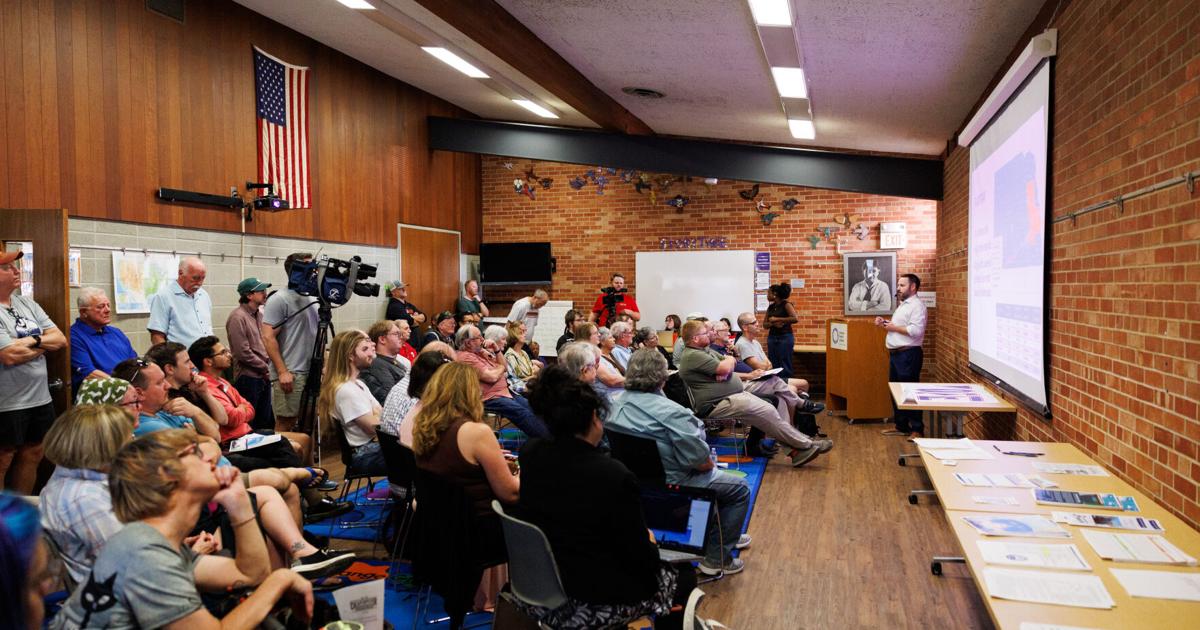
State Sen. Margo Juarez of Omaha and advocates for expanded passenger rail options said at a town hall meeting Monday that they envision train possibilities ranging from connectivity to major metro areas like the Twin Cities to being able to ride almost all the way to Norfolk to whitewater raft.
They also emphasized that Nebraska is “at the starting line” when it comes to rail.
Matt Roque, president of ProRail Nebraska, said the first steps are to work with the Legislature on updating Nebraska’s 20-year-old state rail plan and rejoin the Midwest Interstate Passenger Rail Compact.
Nebraska’s rail plan is the oldest in the country and well past the five-year age limit to be eligible for funds from the Federal Railroad Administration, Roque said. Rejoining the compact will facilitate rail connectivity to other states and could lay groundwork for ideas like a commuter bus between Omaha and Lincoln, Roque said.
He told the crowd of several dozen people that overflowed from a meeting room at Omaha’s Willa Cather library branch to show up during the next legislative session to support Juarez’s efforts.
She plans to introduce a bill to rejoin the compact, which the Legislature voted in 2015 to leave, citing the low return on investment. But some lawmakers have unsuccessfully attempted to rejoin it. Roque said the annual cost is about $25,000. Juarez also is backing Legislative Resolution 203 to authorize a study of existing passenger rail infrastructure and gather more public input to inform potential legislation — a step toward updating the state rail plan.
The stop in Omaha was the last on a statewide tour to gather feedback and drum up advocacy for passenger rail. They held similar meetings in Columbus, Grand Island, Lincoln and North Platte.
Much of the discussion and input from the crowd focused on big picture connectivity, showing what’s available in areas like Boston and central California.
There were also differing opinions about how to pay for a system, some saying it should be publicly funded, others privately and some saying a mix.
The Nebraska Department of Transportation has already said rail is cost-prohibitive, telling the Nebraska Examiner in August that passenger rail currently is “not viable in the state because the development of such a route would pose a significant cost, and there is currently no mechanism to pay for such a project with existing state revenue.”
Juarez, other speakers and crowd members said investment in rail is expensive, but it’s also an economic opportunity for businesses and attracting and keeping workforce talent.
Mike Osborn, an attendee who worked for 40 years at Union Pacific, pointed out that towns that were once stops on rail lines have seen economic downturn as businesses have withdrawn from passenger rail. He said it was disappointing that businesses pulled back from passenger rail because the motivation was based more in the costs of transporting people versus freight rather than diminishing public interest.
At least one idea that Roque said was more immediately workable did emerge. One attendee said Omaha’s Amtrak station location is not convenient for passengers and should be at the Durham museum instead.
Nebraska passenger rail is limited to the Amtrak California Zephyr route, which extends from Chicago to the Bay Area of California. Nebraska’s stops are in Omaha, Lincoln, Hastings, Holdrege and McCook.
The Zephyr travels through Nebraska once per day in each direction, either early in the morning or late at night, making it challenging for commuters. The train heading west departs from Omaha about 11:30 p.m., and the train heading east leaves about 5 a.m.
The schedule is “one of the things we want to fix,” Roque said. He said rejoining the regional compact could create opportunity to advocate for a commuter-focused line between Chicago and Denver that benefits Nebraska — the inconvenient stop times in Nebraska are mainly to ensure the tourism-oriented Zephyr passes through scenic areas like the Rocky Mountains during daylight.
Juarez, whose interest in public transit stems from her use of it while living in Salt Lake City and on various trips, acknowledged that the ideas shared would take a long time, cost a lot of money and be up against a car-centric culture in Nebraska, but said, “It’s OK for us to keep dreaming and keep on our federal officials and state officials to consider what I feel is an investment that should be made in Nebraska.”
Get Government & Politics updates in your inbox!
Stay up-to-date on the latest in local and national government and political topics with our newsletter.
* I understand and agree that registration on or use of this site constitutes agreement to its user agreement and privacy policy.
Josh Reyes
Get email notifications on {{subject}} daily!
Your notification has been saved.
There was a problem saving your notification.
{{description}}
Email notifications are only sent once a day, and only if there are new matching items.
Followed notifications
Please log in to use this feature
Log In
Don’t have an account? Sign Up Today



